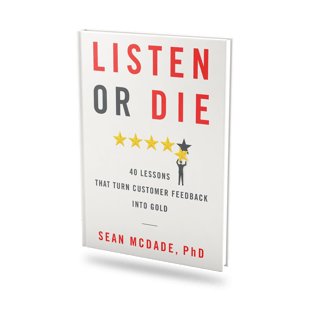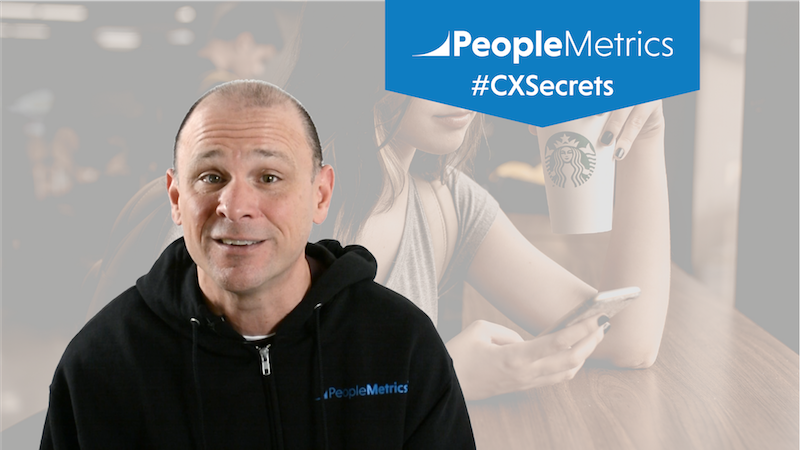Are you familiar with all the different ways your customers interact with your business? Whether you're a seasoned CX professional or you've never heard of CX, chances are you at least have some basic notion of the areas, or touchpoints, where customers interact with your organization. Your website, call center or storefront are all examples of possible customer touchpoints.
When mapping out these touchpoints to better understand the customer journey, some companies will identify 5 to 10 touchpoints, while others might identify 50 or 100. Numbers aside, though, companies often tend to overlook one vital touchpoint when conducting these mapping exercises: the touchpoint of asking their customers for feedback.
In this edition of #CXSecrets, I will reveal why it is essential to include customer feedback collection as a part of your overall customer touchpoint map, as well as a few quick tips for optimizing the feedback collection experience.
Watch this edition of #CXSecrets above, or click here to download the video transcript.
Touchpoints vary
Touchpoints will vary depending on the type of business you're in. If you're a B2B company, you may think about the first interaction prospects have with your sales team. If you're a hotel, you may think about the first interaction guests have with the doorman, or the team at the front desk. If your business makes frequent home visits to customers, a touchpoint might be your customers' first interaction with your field reps.

The forgotten touchpoint
The one touchpoint that most people forget about, however - and it's a very important one - is the touchpoint when you reach out to your customers and ask them for feedback. That is a touchpoint in and of itself.
 Photo by Guilherme Stecanella on Unsplash
Photo by Guilherme Stecanella on Unsplash
The experience that your customers have as they're providing feedback affects their NPS score going forward in the same way that your other touchpoints, like your website or call center, affect NPS.
If a customer has a negative experience providing you feedback, it affects their likelihood to come back, their likelihood to buy more, and their likelihood to continue using your products & services.

via Giphy
Optimizing the feedback collection experience
Think really hard about how you're interacting with your customer when you're asking them for feedback. Are you doing it on their time, in a way that they would want to provide feedback? Are you asking for feedback in a way that’s as short as humanly possible so you're not wasting their time?
Here at PeopleMetrics, I encourage my team to create surveys and feedback mechanisms that somebody can complete while standing in the line at the supermarket. It can't be any longer than that when you're asking for customer feedback.

Do you have time to complete a quick survey? (Photo by Damian Gadal on Flickr)
Would you take your survey?
Consider this: if you were your customer and you got your organization's survey (or other mechanism to provide feedback), would it be a fantastic experience? Would you recommend that experience to others?
Customer experience is cumulative. Every touchpoint counts towards the bigger picture. Be sure to dedicate time to optimize this vital piece of the customer journey, and your overall customer experience program will reach greater heights.
More #CXSecrets
Thanks for joining us for another edition of #CXSecrets, a video series capturing bonus material from my book Listen or Die: 40 Lessons That Turn Customer Feedback into Gold.

Visit our YouTube channel to see all of the videos in the series, or click the links below to see other videos in the series:
| « PREVIOUS: Don't Limit Feedback Opportunities |
| NEXT: Use Your VoC Program to Quickly Answer Strategic Market Research Questions » |
Sean McDade founded PeopleMetrics in 2001 and he is the architect of the company’s customer experience management (CEM) software platform. As CEO, he guides the company’s vision and strategy. Sean has over 20 years of experience helping companies measure and improve the customer experience. Earlier in his career, he spent five years at the Gallup Organization, where he was the practice leader of their consulting division. His company offers CEM software with advanced machine learning solutions and hands-on analytical support to help companies make sense of their CX data. Sean holds a Ph.D. in Business Administration with a specialization in marketing science from Temple University in Philadelphia. He has published eight articles in peer-reviewed scholarly journals and has taught over 25 marketing classes. Sean was named a 40 under 40 award recipient of the Philadelphia region. He is an active Angel Investor, including investments in Tender Greens, CloudMine and Sidecar.
P.S. What did you think of this blog post?
 |
 |
 |






%20(1).png)